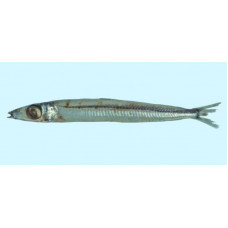Latin name
Glossanodon australis
Other name
Glossanodon australis
Identification
Glossanodon: Greek, glossa = tongue + Greek, anodos = without teeth.
These are small fish, similar in appearance to the smelt, but with a much smaller mouth. They have an elongated body covered with small scales. They also have a small mouth and large eyes on the sides of the head.
Features of fish fins
The tail fin is bifurcated. The dorsal fin is single, located near the centre of the body.
Fish colouring
The body is silvery coloured. The species has a dark longitudinal stripe along the midline above the lateral line and a pigmented throat area.
Distribution
Widespread in the southwest Pacific: off the coast of eastern Australia, including the Tasman Sea.
Habitat
A marine bottom-dwelling fish that prefers temperate climates. Habitat depths range from 140m to 331m.
Size
Males reach a maximum length of 19.1 cm.
Behavior
They live in large groups near the bottom.
Food and feeding habits
They feed on plankton, with krill as the mainstay of their diet, along with amphipods, small cephalopods, bristlebacks and scallops.
Reproduction
The biology of this species has not been studied. Their eggs are probably small (1 to 3 mm in diameter) and pelagic. Larvae are pelagic, larval development is gradual, transformation into immature individuals is accompanied by a transition to a benthic lifestyle.
Fishing
This species is not commercially important.
Relationship with a person
Harmless.
| Classification | |
| Phylum | Chordata |
| Class | Actinopterygii |
| Squad | Argentiniformes |
| Family | Argentinidae |
| Genus | Glossanodon |
| Species | G. australis |
| Features | |
| Conservation status | Not Evaluated |
| Habitat | Bottom |
| Life span, years | No information |
| Maximum body weight, kg | No information |
| Maximum length, cm | 19,1 |
| Sailing speed, m/s | No information |
| Threat to people | Edible |
| Way of eating | Bentophage |
Southern herring smelt
Tags: southern herring smelt

